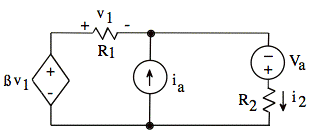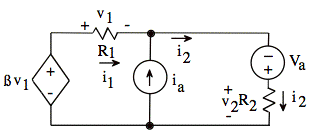|
|
Unit 1 |
|
|
|
PRACTICE EXAM SOLUTION Prob 3 |
3. (30 points)
a. Derive an expression for i2. The expression must not contain more than the circuit parameters ß, Va, ia, R1, and R2.

b. Make at least one consistency check (other than a units check) on your expression. Explain the consistency check clearly.
ans: a) ![]()
b) Many possible answers. See solution below.
sol'n: (a) Use Kirchhoff's laws to write several equations. Then eliminate unwanted variables.

We sum currents out of top-center node:
–i1 – ia + i2 = 0
Note that summing currents out of bottom-center node does not give us anything new. By Ohm's law, we also have
![]()
Now, we sum voltages around a loop. We choose the outer loop because the inner loops have a current source with unknown voltage drop.
![]()
By Ohm's law, we also have
![]()
After the Ohm's law substitutions, we have two equations, and we may eliminate v1.
Use the simpler equation first:
![]() or v1 = (i2 – ia)
or v1 = (i2 – ia)
Substitute for v1 in the second equation:
![]()
After some algebra, we get
![]() units consistent
units consistent
![]()
(b) There are many possible consistency checks.
1) ia = 0 and R1 = 0. Then v1 = 0, ßv1 = 0, and sum v's around outer loop gives i2 = Va/R2. Our formula also gives Va/R2. ![]()
2) Consider R1 = 0 and R2 = 0. As in (1), v1 = 0 and ßv1 = 0. Since R2 = 0 we also end up with a short across Va:

Our formula gives

![]()
3) Consider ia = 0, ß = 0:

Our formula gives
![]()
![]()
4) Consider ![]() (open circuit)
(open circuit)

Our formula gives:

![]()
5) Consider
![]() (open circuit): We
have i2 = 0 since no
current flows through the open circuit. Our formula gives:
(open circuit): We
have i2 = 0 since no
current flows through the open circuit. Our formula gives:
![]()
![]()
Many more consistency checks are possible.